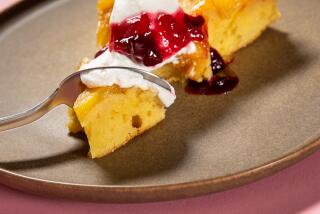Test Kitchen tips: Choosing and storing citrus

- Share via
When shopping for citrus, choose fruit that are heavy for their size -- they’ll be the juiciest. And look for fruit with nice, tight skins. Avoid fruit that are wrinkled or spotted, or feel lightweight. You can generally tell the ripeness of the fruit by the thickness of the rind -- the thinner the rind, the more ripe and juicy.
Most citrus will keep for several days at room temperature. They’ll also keep well in the refrigerator, stored in the crisper for up to several weeks. Thin-skinned citrus such as mandarins or tangerines should be refrigerated right away.
To get the most juice out of your citrus, bring the fruit to room temperature before juicing -- room-temperature fruit will yield more juice than fruit just out of the refrigerator.
If you have any kitchen tips or questions you’d like me to explore, leave a comment below or shoot me an email at noelle.carter@latimes.com.
ALSO:
Mac ‘n’ cheese recipes galore!
Go behind the scenes at the L.A. Times Test Kitchen
You can find Noelle Carter on Facebook, Google+, Twitter and Pinterest. Email Noelle at noelle.carter@latimes.com.
Lemon upside-down cake
Total time: 55 minutes
Servings: 8
Note: From former Times test kitchen director Donna Deane. May be served with a lightly sweetened whipped cream, if desired. Published March 14, 2007.
4 small lemons (about 4 ounces each)
One-half cup plus 2 tablespoons (1 1/4 sticks) butter, divided
3/4 cup packed light brown sugar
1 1/2 cups flour
1 1/2 teaspoons baking powder
1/2 teaspoon salt
1 vanilla bean, split
3/4 cup sugar
2 eggs
1/2 cup milk
1. Cut 3 of the lemons into one-eighth inch thick slices. Remove seeds and set aside. You will have about 30 lemon slices. Grate 1 teaspoon lemon peel from the remaining lemon. Set aside the grated peel; save the lemon for another use.
2. Heat 4 tablespoons of the butter in a 10-inch cast iron skillet or an ovenproof 10-inch saute pan until melted. Brush the sides of skillet with a little of the melted butter. Add the brown sugar, stir until it is moistened with the butter and spread it into an even layer. Arrange the lemon slices, slightly overlapping, to cover the bottom of the skillet. Set aside.
3. Heat the oven to 350 degrees. Combine the flour, baking powder and salt in a bowl and set aside.
4. Cut the remaining 6 tablespoons butter into a mixing bowl. Scrape the seeds from the vanilla bean with the point of a knife onto the butter. Using an electric mixer, beat the butter, scraping down the sides of the bowl, until creamy. Add the sugar and grated lemon peel and beat until light and fluffy. Beat in the eggs one at a time.
5. Add half the flour mixture and beat until blended. Add milk and beat until combined, then add the remaining flour mixture and beat until blended.
6. Spread the batter over the lemons in the skillet to cover evenly. Bake 30 to 35 minutes, or until the cake is golden and the center tests done. Let the cake stand 5 minutes, then invert the skillet onto a platter. To serve, slice into wedges with a sharp knife.
Each serving: 498 calories; 5 grams protein; 62 grams carbohydrates; 3 grams fiber; 28 grams fat; 17 grams saturated fat; 122 mg. cholesterol; 274 mg. sodium.
More to Read
Eat your way across L.A.
Get our weekly Tasting Notes newsletter for reviews, news and more.
You may occasionally receive promotional content from the Los Angeles Times.











